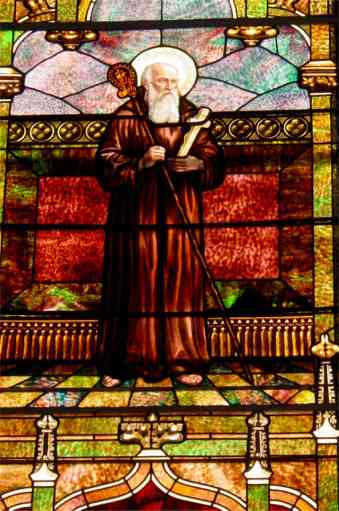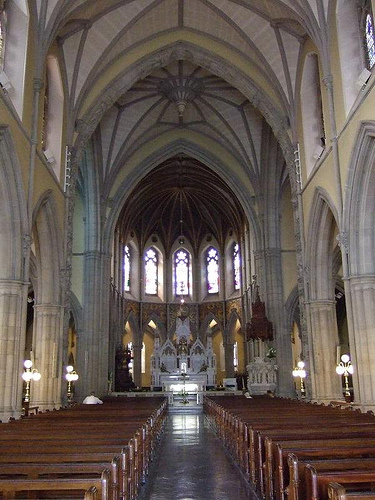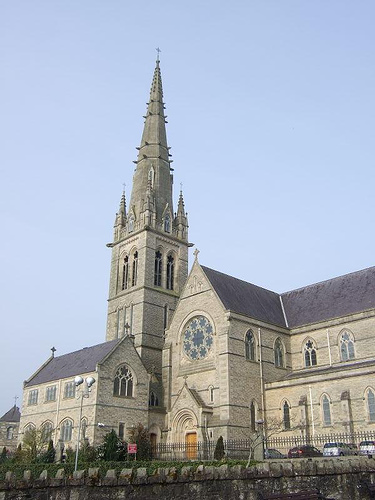St. Adamnan of Ireland, Abbot
He was the eighth in descent from the great Nial, king of Ireland, and from Conal the Great, ancestor of St. Columbkille. His parents were eminent for their rank and virtue. He was born in the year 626, at Rathboth, (1) now called Raphoe, in the county of Donegal, and embraced a monastic life with great humility and fervour, in the monastery which had been founded there by his kinsman St. Columb. Afterwards following the steps of his holy kinsman, he left Ireland, and retired to the celebrated monastery of Hij, of which he became fifth abbot.
In 701 he was employed by Longsech, king of Ireland, on an embassy to Alfred, king of the Northern Saxons, to demand of the latter a reparation of the injuries committed by his subjects on the province of Meath, and carrying off the effects of the inhabitants before the troops of the Irish could arrive to chastise those invaders. Adamnan succeeded happily in this negotiation: he was favourably received by the Saxon monarch, and obtained full satisfaction for all the damages done to his countrymen in the foregoing year. While he continued in England he laid aside the custom of his predecessors, and conformed to the true time of celebrating Easter. Upon his return home, says Bede, (2) he used his utmost endeavours to guide his monks of Hij, and all those who were subject to that monastery, into the road of truth, which he himself walked in, but was not able to prevail. He therefore sailed into Ireland, his native country, and there preached to the natives, and with modest exhortations explained to them the true time for observing Easter: by which means he brought almost the whole island to a conformity with the universal church in that point of discipline. Having remained in Ireland to celebrate that festival according to the canons, he afterwards returned to Hij, and earnestly recommended to his own monks to conform in this particular to the Catholic custom; but did not compass his ends before his death, which happened in 705. However, he left among them a judicious treatise, On the right time of keeping Easter, which disposed them some time after to forsake their erroneous computation.
St. Adamnan wrote the life of St. Columbkille; he also wrote certain canons, and a curious description of the Holy Land, as that country stood in his time. This book furnished Bede with his principal memorials, (l. De Locis Sanctis; and is published by Gretzer, and by Mabillon, t. 4, Act. Ord. St. Benedicti, p. 456). He mentions the tombs of St. Simeon and of St. Joseph at Jerusalem, many relics of the passion of Christ, the impression of the feet of our Saviour on Mount Olivet, covered with a church of a round figure, with a hole open on the top, over the place of the impression of the footsteps; he also mentions grasshoppers in the deserts of the Jordan, which the common people eat, boiled with oil; and a portion of the cross in the Rotunda church in Constantinople, which was exposed on a golden altar on the three last days of Holy Week, when the emperor, court, army, clergy, and others went to that church at different hours, to kiss that sacred wood. (3)
The festival of St. Adamnan is kept with great solemnity in many churches in Ireland, of which he is titular patron, and in the whole diocese of Raphoe, of which he was a native.
Note 1. Rath, in old Irish, signifies a town or military inclosure, and Both, a booth, or cottage: so that Rathboth is a town made up of cottages.
Note 2. Hist. Eccles. l. 5, c. 16.
Note 3. See Mabillon, t. 4. Act. Ord. Bened. p. 456. Bp. Tanner, de Scriptor. p. 5.
You can read the Life of St. Columba by St. Adamnan, Ninth Abbot of that Monastery here: http://www.fordham.edu/halsall/basis/columba-e.asp









